June is a fantastic month in the garden when many stunning perennials burst into bloom The selections are diverse – from classic garden favorites to unique beauties Planning beds and borders with June bloomers ensures waves of color throughout the month.
Here are 12 of the best perennials that bloom in June
1. Peony
Peonies are loved for their sumptuous, romantic blooms in shades like pink, white, red and yellow. The large, fragrant flowers on bushy plants add incredible impact to gardens in late spring and early summer. Tree peonies and intersectional Itoh peonies also bloom in June, adding their huge, exotic blooms to the mix.
2. Delphinium
Delphinium produce tall spires densely packed with petaled flowers in colors like blue, purple, pink and white. Their tower-like blooms add vertical drama to beds and borders. Some varieties will remnant bloom if promptly deadheaded.
3. Salvia
Salvia offer long-blooming, tapered flower spikes that come in hues spanning the entire color wheel. The nectar-rich blooms attract pollinators in droves. Varieties range in height from compact to towering.
4. Yarrow
This pretty perennial flowers in umbrella-shaped clusters called corymbs. Popular varieties like ‘Paprika’ and ‘Summer Pastels’ bloom in mixes of hot colors. Fern-like foliage provides lovely texture all season long.
5. Tickseed
Tickseed (Coreopsis) are daisy-like perennials that flower abundantly in June. Colors include yellow, red and bi-color varieties. The bright blooms stand out with their contrasting centers. They work beautifully in pollinator gardens.
6. Garden Phlox
Garden phlox produce panicles of sweetly fragrant blooms in pink, purple, red and white. They add incredible color impact to summer garden beds. Some varieties are mildew resistant for low maintenance.
7. Astilbe
The feathery plumes of astilbe bring graceful, colorful impact to shade gardens in June. They come in lovely shades like pink, red, purple and white. Even when not in bloom, their fern-like foliage offers wonderful texture.
8. Lavender
Few perennials are as instantly recognizable as lavender when in full bloom. The pretty purple flower wands smell as good as they look. Blooming on silvery foliage, they are perfect for borders, containers or herb gardens.
9. Asiatic Lily
Large, exotic blooms on sturdy stems make Asiatic lilies a star player in June gardens. These easy perennials come in a range of brilliant colors like orange, yellow, pink and red.
10. Coneflower
Coneflower (Echinacea) are classic prairie native perennials grown for their brightly colored daisies and benefits to pollinators. Varieties offer single, double and unique petal forms.
11. Coral Bells
While loved for their foliage, coral bells (Heuchera) also produce dainty spikes of bell-shaped blooms that make lovely cut flowers. Look for new varieties with extended bloom times.
12. Shasta Daisy
A garden staple, Shasta daisies bloom elegantly in June with their white petals and sunny yellow centers. They pair nicely with any color scheme and make superb cut flowers. Deadhead for extended blooms.
Pairing Perennials for Succession Blooms
The key to having non-stop color in flower beds is to combine perennials with successive bloom times. Here are some examples of great pairings:
- Peonies + Astilbe + Lavender
- Delphinium + Salvia + Phlox
- Yarrow + Lilies + Coneflower
- Coreopsis + Astilbe + Coral Bells
Caring for June Blooming Perennials
To get the most out of June perennials, provide care that keeps them flowering their best:
- Deadhead spent blooms to promote reblooming
- Apply organic fertilizer when buds appear
- Water during dry periods to support flowering
- Stake tall bloomers like delphinium to prevent flopping
- Divide when clumps get overcrowded (about every 3-5 years)
- Cut back by 1/3 after main flush of blooms concludes
Extending the Bloom Season
You can maximize the bloom time with these simple tips:
- Choose reblooming or repeat flowering varieties
- Promptly deadhead fading blooms
- Provide consistent watering and fertilization
- Give plants ideal sun exposure for their variety
- Avoid excessive competition from aggressive plants nearby
June offers a bounty of spectacular blooming perennials like peonies, lavender, salvia and coneflowers. Combine different bloom times in the garden for non-stop color. Give plants proper care and conditions to maximize flowering. With a diverse blend of June bloomers, you can craft a landscape that really puts on a show this month.
Iris ensata ‘Rose Queen’
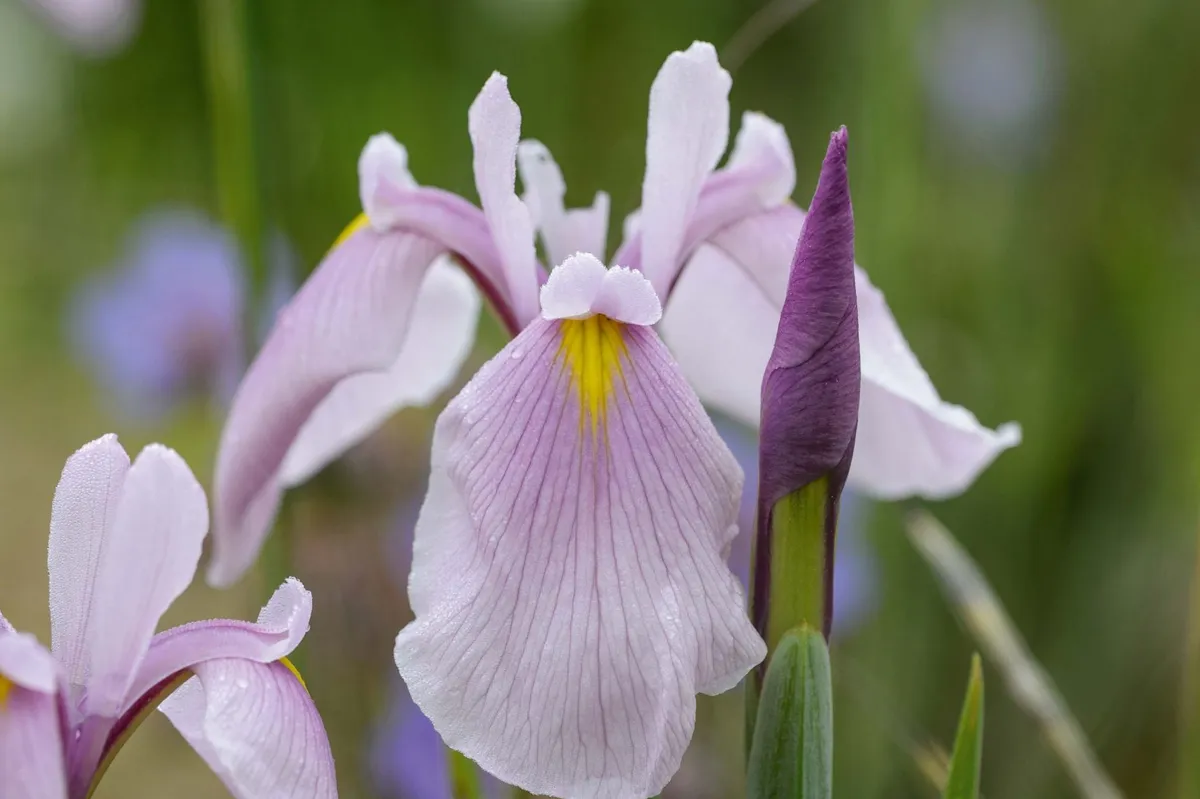
The Japanese water iris, which is still sometimes called Iris kaempferi, grows best in shallow water but likes it dry when it’s not in bloom. In its home country of Japan, where it comes from, pond levels are often changed throughout the year to make it happy.
That being said, it doesn’t have to be grown in water as long as the soil can hold water, and it looks best when it is growing near water. ‘Rose Queen’, with its distinctive flower colour, has smaller, more delicate flowers than many other ensatas.
AGM. Height 75-90cm. Origin Garden origin (species from Japan and the Far East). Conditions Rich, moist soil; full sun. Hardiness RHS H6, USDA 5a-8b. Season of interest Early summer.
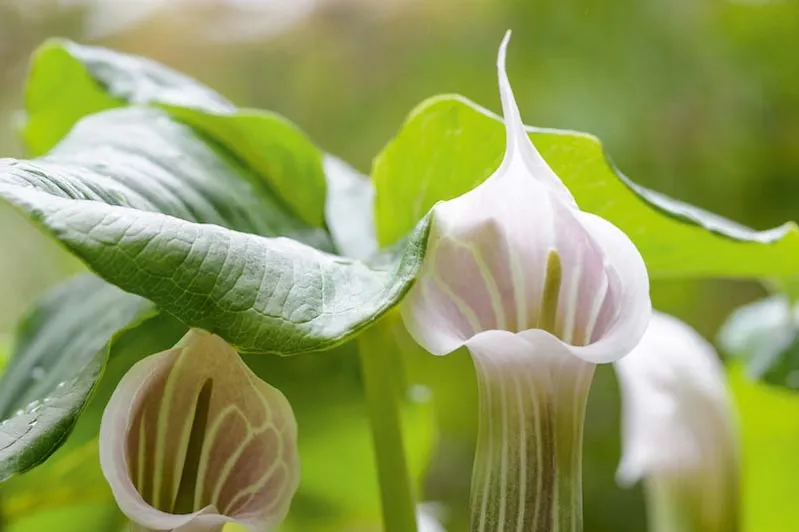
The distinctive stripy pink spathes of this exotic-looking aroid make it one of the best arisaemas for flowering. It emerges from the ground as late as early June, and quickly produces flowers before the leaves appear. Once it has settled down, these three-leafed leaves can grow up to 45 cm across. At that point, it’s a very pretty late-summer foliage plant.
After the first frost in the fall, this show will be over. For the next seven or eight months, it will be below ground as round and flattened, fleshy tubers, so make sure you mark its spot well and cover it with a thick layer of mulch.
AGM. Height 30cm. Origin China. Conditions Warm spot in part shade. Hardiness RHS H4, USDA 5a-7b. Season of interest All summer.
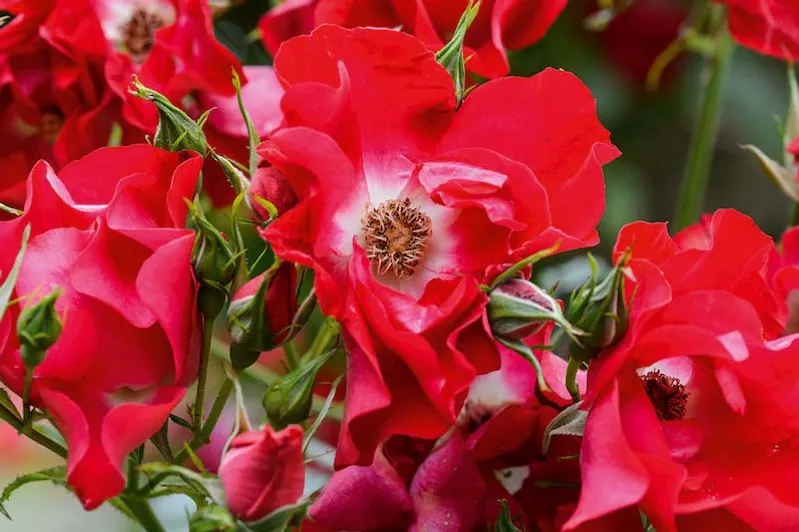
This is a climbing rose with shiny green leaves and clusters of red flowers with a white center that bloom all summer and into fall. The flowers are followed by pretty orange hips.
Without using any chemicals, this rose has always given us clean leaves and lots of flowers for 40 years. It grows in a part of the country that gets a lot of rain, where most roses won’t last more than a year or two without being sprayed regularly. It’s painful to clean up and tie it in every year because it has thorns, but it’s so worth it.
AGM. Height 3m. Origin Garden origin. Conditions Moist but well-drained soil; full sun. Hardiness RHS H5, USDA 4a-10b. Season of interest All summer.
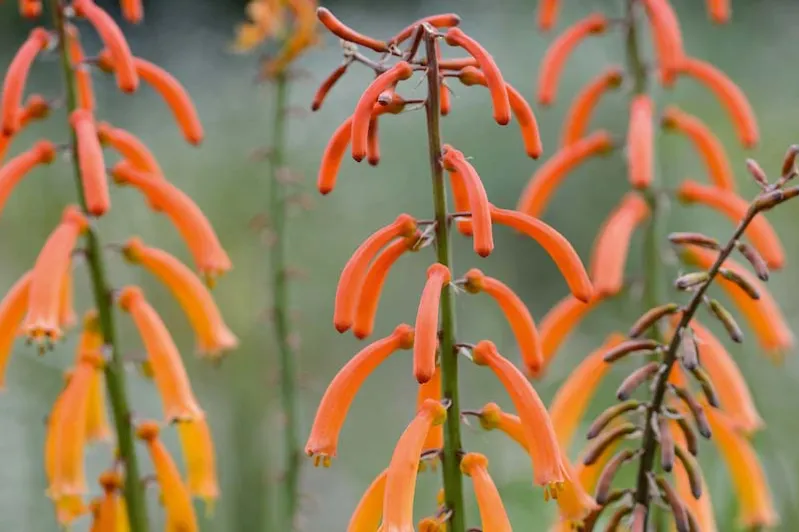
This Kniphofia is very different to most people’s vision of a red hot poker. Instead of a spike of flowers close together, this species has soft orange flowers that are spread out and curve down gracefully, more like an aloe. The way it grows is also different. Like the flowers, it doesn’t form a big clump. Instead, it spreads out slowly, making a colony of rosettes, each with a few leaves lying down.
Repeat flowering through the summer. One thing that might be bad about it is that it’s not quite as hardy as some
Height 60-90cm. Origin East Africa. Conditions Well-drained soil; full sun to light shade. Hardiness RHS H3, USDA 7a-10b. Season of interest Summer.
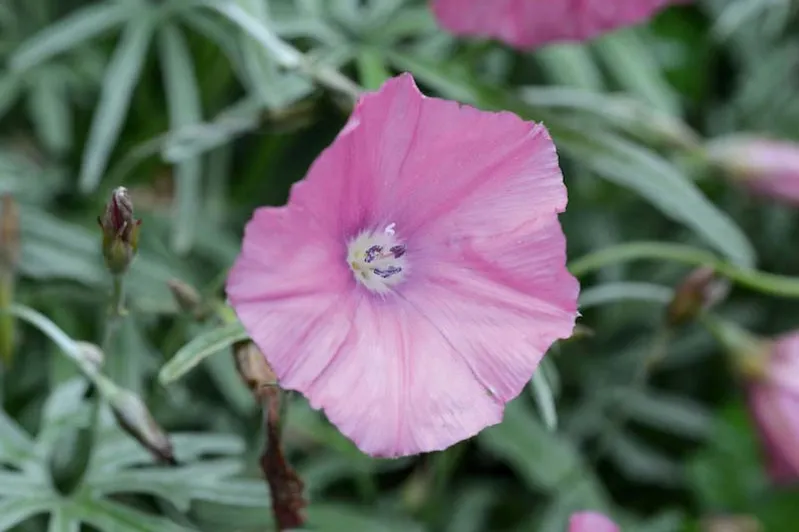
A bindweed that I actually love. It’s been more than 25 years since I first got a tiny root to live and grow. It was first seen on the island of Crete, where it covered tilled ground between olive groves and large, steep, sunny roadside verges. It was not until I managed to replicate those conditions did it deign to settle in and spread.
Now it grows underground and spreads its pretty silver leaves and clean pink flowers through a soft purple-blue catmint. It’s a beautiful sight that lasts for weeks.
Height Scrambling to 60cm. Origin Mediterranean. Conditions Well-drained soil; full sun. Hardiness RHS H3-4, USDA 6a-8b. Season of interest All summer.
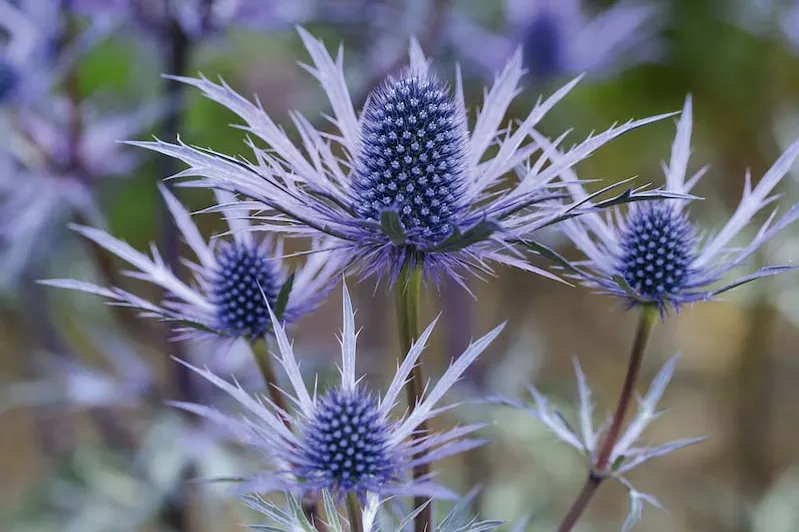
Because some species of Eryngium grow naturally near the water, they are often called sea hollies. This is because their leaves are very sharp. But in a garden, all they need is a sunny, well-drained spot. For many weeks in the summer, they will grow their shocking, cone-shaped flowerheads surrounded by what look like poisonous bracts.
There are several cultivars of this hybrid, and the blue in the flowerheads and stems varies slightly between them. All of them are good, though. Easily propagated by root cuttings in late winter.
Height 60-90cm. Origin Garden origin. Conditions Well-drained soil; full sun. Hardiness RHS H5, USDA 6a-9b. Season of interest Summer.
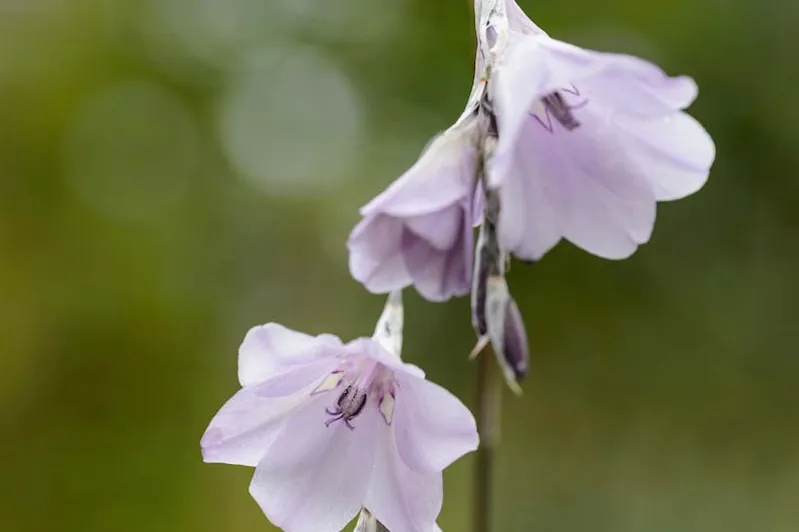
Wand flowers, or more romantically angel’s fishing rods, are one of my favourite perennials. With their wiry, evergreen, grassy leaves, many visitors ask us what the flowering grasses are. Dieramas are actually bulbs that come from South Africa. Most of the species grow high up, which means they can survive in most of the UK.
This species flowers later than most, usually from June to July. The bell-shaped flowers can be pink, purple, white, or pale amethyst. The silvery seedheads that follow are also attractive, moving in the slightest breeze.
Height 1-2m. Origin South Africa. Conditions Well-drained soil; full sun. Hardiness RHS H3-4, USDA 8a-10b. Season of interest Late summer for flowers.
June flowers: the best blooms for June
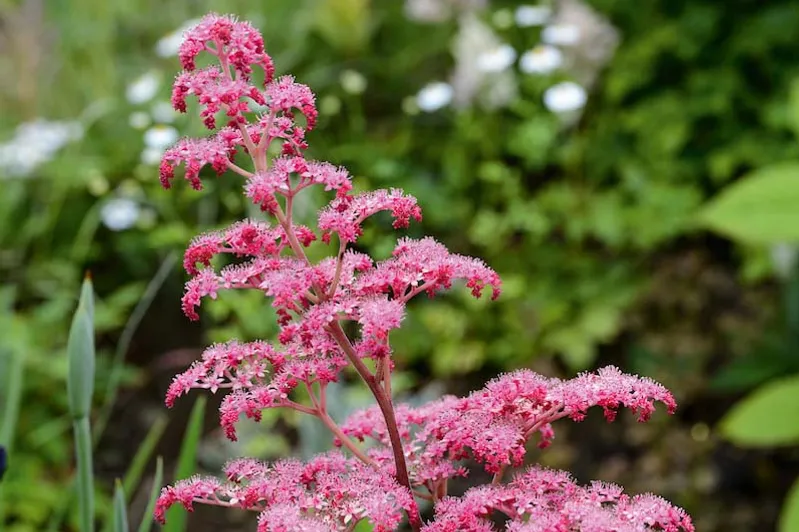
A dark-pink seedling we raised from Rodgersia pinnata ‘Superba’ while at the Garden House. In the wild, rodgersias often grow on stream banks and like a moisture-retentive soil, without being waterlogged. When this cultivar flowers, the flowerheads turn a dark red color. They look great in dried flower arrangements. The pretty wavy leaves don’t show up until late spring. The flowering stems come up first, so they are more likely to be damaged by late spring frosts at this point. This late leafing means it is possible to grow early spring bulbs among the roots.
AGM. Height 1m. Origin Garden origin, species from China. Conditions Moist but well-drained soil in full sun/part shade. Hardiness RHS H4, USDA 3a-8b. Season of interest All summer.
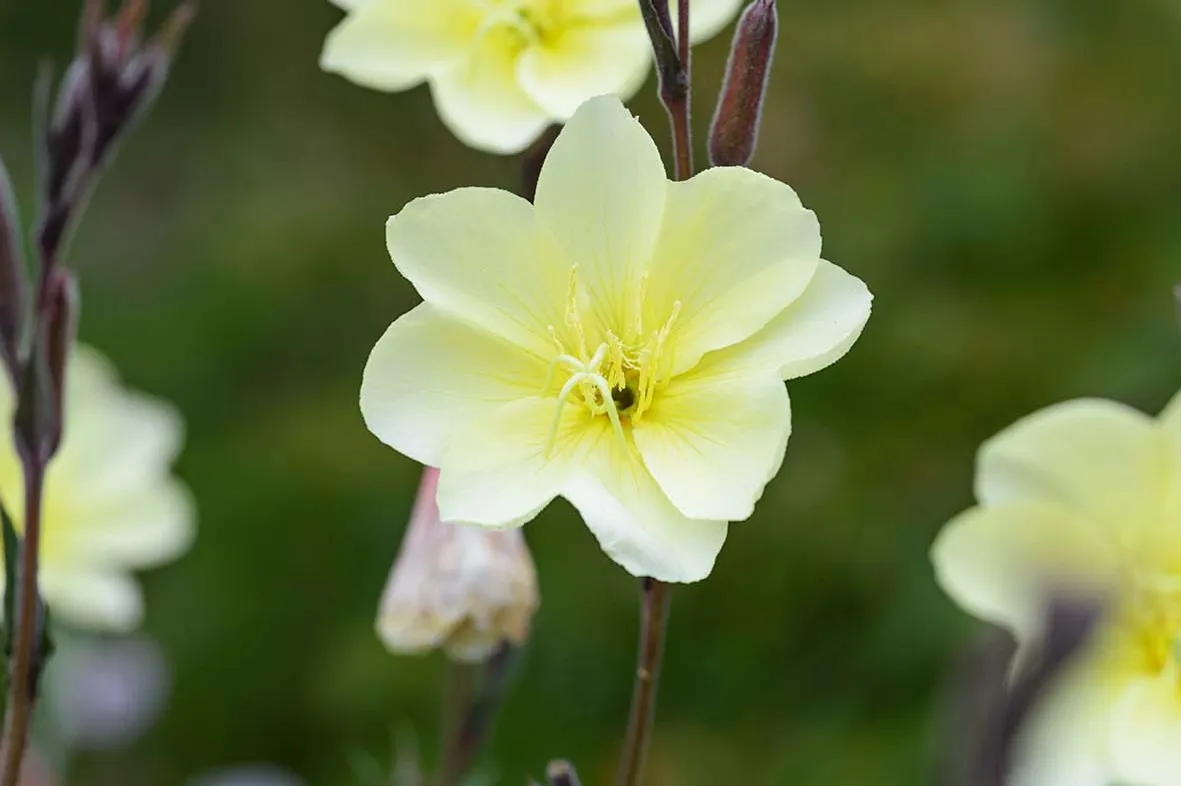
The Chilean evening primrose in a pale yellow color. This is a short-lived perennial or biennial that I hope I never lose. Since it will spread its own seeds, there should be no reason to lose it as long as there is empty space for the seedlings to grow.
The fragrant flowers open a pale yellow color in the late afternoon, as their name suggests. By morning, each one has turned a beautiful apricot color for its last few hours before falling off. It looks even better because the buds and stems are flushed with purple-red color.
Height 60-90cm. Origin Garden origin (species from Chile). Conditions Any well-drained soil; full sun. Hardiness RHS H5, USDA 6a-10b. Season of interest All summer.
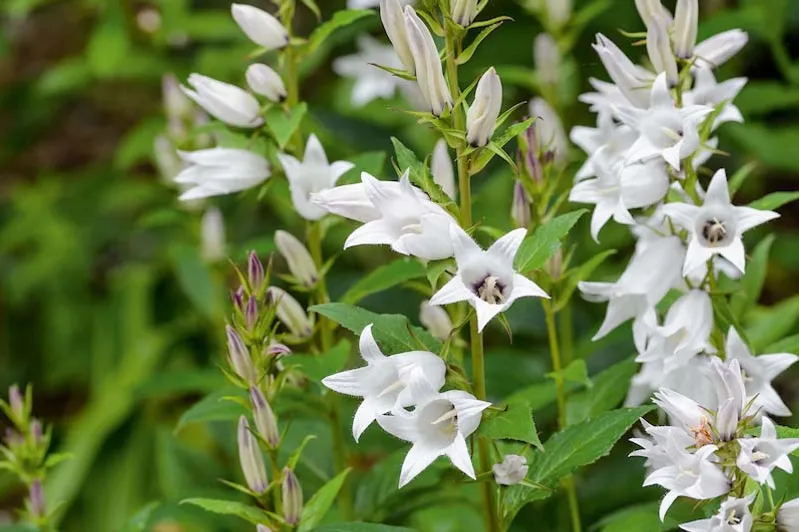
Another plant we raised while we were at the Garden House. A seedling from the pure-white Campanula latifolia var. There is a purple eye and a faint flush of that color in the white that makes this a more elegant-looking perennial. I have never had to stake this plant because it grows straight up, and the clump doesn’t take up much ground space, so it can be used to add height to lower-growing perennials.
After flowering the skeletal seedheads are also attractive for a short period before they are best cut back.
Height 1m. Origin Garden origin (species from Europe and western Asia). Conditions Any soil; full sun to part shade. Hardiness RHS H5, USDA 4a-9b. Season of interest Summer.
6 Early Summer Blooming Perennials
FAQ
What perennial flowers are in June?
What is the longest flowering perennial?
Is there a perennial flower that blooms all summer?
What flower blooms in May and June?
What flowers bloom in June?
Roses are a popular flower for bouquets, and they typically bloom in June and continue blooming through fall. Poppies are delicate and beautiful flowers with petals that come in a variety of colors, such as red, white, yellow, orange, and pink. They have four to six petals that are often fringed or crinkled.
What flowers should I plant in June?
With a tropical look and nature, Asclepias is an ideal flower to plant in June. The vibrant blooms and sweet milkweed nectar attract important pollinators like monarch butterflies and beneficial insects. Milkweed is a food source for monarch caterpillars and shelter for their chrysalis (beautiful in green with a trim of gold threading).
Can you plant perennials in June?
There are a number of different options to choose from, even in the heat of the summer! In this article, gardening expert Jill Drago walks through 15 of her favorite perennials you can plant in the month of June! When June arrives your spring blooms are beginning to fade, and your perennials are just about ready to start blossoming.
What flowers bloom all summer?
‘Astra Double Blue’ is a dwarf variety that blooms all summer and it can be ordered through Nature Hills. Read more about growing balloon flower here. 4. Bee Balm (Monarda didyma) Bee balm, or wild bergamot, is a tall, attractive perennial with whorls of tubular flowers that add a bold punch of color to the late summer garden.
What flowers bloom in August?
These summer-blooming perennials and perennials that bloom in August are special because not only can they thrive in the heat, but they also draw a wide variety of pollinators to your garden. Light: This perennial, also known as sage, has woody stems, grayish leaves and blue to purple blooms. It prefers full sun.
Can I start perennial flowers in June from seed?
While it is still possible to start some perennial flowers in June from seed, you will get more out of them if you buy young plants from the garden center or nursery, as you’ll have more time to enjoy their blooms this season.
- The Ultimate Guide to Growing Strawberries in Raised Beds - August 8, 2025
- No-Dig Garden Beds: The Easiest Way to Grow a Beautiful Garden - August 6, 2025
- How to Protect and Preserve Wood for Raised Garden Beds - August 6, 2025
